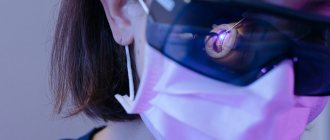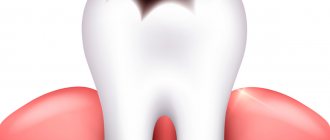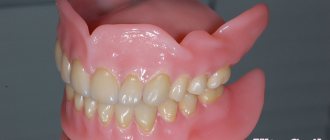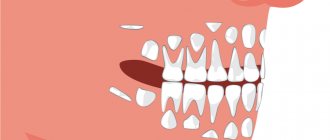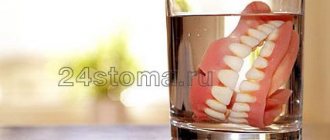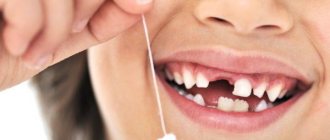Changing children's baby teeth to permanent ones is always an exciting time for parents. This process is quite lengthy and often painful for the child, because it can be accompanied by various inflammations and discomfort. To help parents, for a better understanding of the physiological processes associated with the formation of teeth, dentists offer to look at the pattern of loss of baby teeth in children.
Bookmarking teeth
The formation of baby teeth occurs at approximately 4-6 weeks of fetal development. At the same time, the formation of the fundamental elements occurs much later - during the first months of the child’s life. For this reason, new mothers who are bottle-feeding are strongly recommended to supplement their baby’s diet with calcium. This substance promotes the proper formation of tooth enamel.
At an early age, unprotected baby teeth are extremely susceptible to carious lesions. Parents should monitor this closely, as infection can subsequently cause destruction of permanent teeth. The fact is that the rudiments of permanent teeth are in close proximity to the roots of milk teeth, so as soon as you discover dark spots on your child’s enamel, immediately go to pediatric dentistry.
Diseases of baby teeth
The most common troubles are caries (including bottle caries), pulpitis, periodontitis.
You should be alerted to any changes in the color of the enamel, spots, dots (both dark and white) on the child’s teeth, redness or swelling of the gums. But you don’t have to be afraid of uneven teeth at first: when chewing solid food, the baby teeth will move a little and gradually take the right place.
The causes of diseases in primary teeth are not very different from the causes of problems with permanent teeth. This:
- insufficient care for them (lack of proper hygiene),
- eating disorders,
- undermining of the immune system due to other diseases and taking certain medications.
It is a mistake to think that you can't take too much care of your baby teeth because they will fall out anyway. A diseased tooth in the mouth is a breeding ground for pathogenic bacteria, which not only destroy other teeth, but also negatively affect digestion and ENT organs. A prematurely lost baby tooth is also a problem, as it does not allow the baby to fully chew food or articulate sounds well. In addition, neighboring teeth try to occupy the vacated space - they move. And when a permanent tooth begins to grow here, it simply does not have enough space in the dentition and will have to grow sideways. That’s why it’s imperative to keep an eye on your baby teeth and treat them on time!
We ourselves, out of ignorance, introduce some pathogenic bacteria into the baby’s oral cavity. Suffice it to remember my grandmother’s method of disinfecting a fallen pacifier: lick it and put it in the baby’s mouth. How many times have we done this? Did you feed the child with your spoon? Did you take turns biting an apple or a bun with him? Imagine for a moment the state of your teeth and the newly formed, not fully formed, delicate teeth of the child. What danger did you expose them to?
Foreign microflora is especially harmful to a child under 2 years of age, while temporary teeth are maturing in his mouth and their enamel is very vulnerable.
Leftover food also contributes to the rapid proliferation of bacteria in the oral cavity. A by-product of their activity is acid, which eats away the enamel of a baby tooth, leaving its delicate base - dentin - without protection. Then it’s a matter of little things: microorganisms penetrate the dentin and destroy it. This is how caries occurs. Outwardly, a diseased tooth may look normal for quite some time: a small black dot (the site of the lesion) is not too noticeable. But inside it can already be severely damaged, since caries of baby teeth, due to the softness of their tissues, develops much faster than permanent teeth.
There is also the so-called “bottle caries” - this is a brownish plaque on the front teeth. It is very resistant and cannot be cleaned with a brush. Such teeth rot quickly. This caries is called “bottle caries” because it is a consequence of feeding the baby from a bottle with sweet drinks and juices at night and throughout the night. Carbohydrates are known to be the best food for bacteria. Receiving such wonderful nutrition, pathogenic bacteria rapidly multiply and take over the entire territory available to them. It will be very difficult to force them to give up their positions. The development of “bottle caries” is also facilitated by the fact that at night the natural protector and cleaner of teeth – saliva – is almost not produced. While you are sleeping peacefully, your baby’s fragile little teeth are under powerful attack and are not protected by anything! Is it worth it to buy yourself a vacation at such a price?
Dangerous complications of caries are pulpitis and periodontitis.
Pulpitis is an inflammation of the pulp (the core of the tooth, filled with vessels and nerve fibers). In children, the pulp is practically insensitive, so they may not feel the usual sign of pulpitis - sharp pain. As a result, pulpitis of baby teeth may not be noticed even by an attentive parent, and the role of preventive examinations by a dentist is irreplaceable here.
If bacteria pass through the root of a baby tooth and enter the gum tissue, inflammation begins - periodontitis. Severe pain and fever are already guaranteed here. The gums become red and swollen. Periodontitis is a serious disease, and a child should never be exposed to it.
By visiting your dentist in a timely manner, you can avoid all these troubles. Caries is very easy to treat. Here, however, the first question comes to mind: where exactly to turn. It turns out that the approach to the treatment of baby teeth in different clinics is very different.
Traditionally, caries of primary teeth is treated “in a hurry”: a small child usually does not really want to endure while the doctor picks around his mouth, so the doctor tries to somehow clean the damaged area and fill it with quick-hardening material. As a result, the affected teeth remain untreated and may soon become inflamed again or completely collapse. Sometimes you even have to put crowns on baby teeth.
“The Nutcracker” uses all the possibilities of modern medicine to provide comprehensive care to the smallest patients: from composite materials to “laughing gas” and Sevoran anesthesia. We are convinced that the treatment of primary teeth should be of high quality, and the child’s impressions of the clinic should be the most pleasant.
Baby teeth in children: loss pattern
Many mothers are concerned about the question of when their children’s baby teeth begin to fall out. As a rule, this process starts immediately before primary school, that is, at the age of 6-7 years. In this case, the pattern of loss of baby teeth in children is similar to the sequence of their eruption. Only the fangs differ, which are replaced later, by the age of 13.
The order in which baby teeth fall out is the same for almost all children. First, molars grow - molars, which were absent in the “milk” set. As soon as there is enough space in the child’s jaw, “sixes” begin to appear. Only after this comes the time to change temporary teeth.
First, the lower incisors fall out, and then the upper ones. After this, the premolars appear at about 9-11 years of age. The last in line are the fangs, which usually fall out by the age of 10-12 years. At the same time, there should already be molars in the child’s mouth. After 18 years, third molars or, as we used to call them, wisdom teeth begin to emerge. However, they do not appear in everyone, which, by the way, does not indicate the presence of any pathologies.
Features of the period.
During this period, the formation and further development of the roots of baby teeth occurs: they are strengthened in the bone tissue of the jaws. The processes of root formation smoothly flow into the processes of their resorption and replacement with permanent teeth, the rudiments of which are located under the milk teeth.
The presence of interdental spaces between the incisors and canines of the upper and lower jaws is a sign of a “normal” correctly developing occlusion of primary teeth. The absence of interdental spaces in the primary dentition indirectly indicates a lack of space for the eruption of permanent incisors and canines, the crowns of which are significantly wider.
PHOTO: Teeth of a 3-year-old child. By the age of 3, a child already has a full set of teeth in his mouth. There should be spaces between baby teeth.
Starting from 5-6 years of age, the bite of temporary (baby) teeth is replaced with permanent ones. This is preceded by the growth of the rudiments of permanent teeth and the physiological resorption of the roots of milk teeth. As the roots of baby teeth are reabsorbed, mobility of these teeth appears. At this age, parents often note mobility of the lower and upper front teeth (deciduous incisors). When the root is completely absorbed, the tooth may fall out on its own: sometimes children “help” the tooth fall out with their tongue, constantly rocking it. Sometimes the “loss” of a resorbed tooth occurs while eating or playing.
Closer to 6 years, the first permanent chewing tooth (first molar) erupts behind the last milk tooth. The eruption of the first permanent molar is not accompanied by the loss of any tooth and does not cause any discomfort to the child, so it often goes unnoticed.
Parents often take the first permanent chewing tooth for additional milk, as it bursts behind all the milk teeth and this does not precede the loss of the milk tooth: it seems that the child has 24 malate tooth.
PHOTO: Milk teeth in children aged 6 years. The lower lateral incisors fell out. Soon permanent lateral incisors will appear in their place.
What should parents do?
The process of changing teeth in children worries parents, but this is quite natural, and most children do not experience significant pain. However, this does not relieve parents of the need to constantly monitor the condition of their child’s oral cavity. There is no need to remove baby teeth yourself. When the time comes to say goodbye to a tooth, a certain mechanism is activated in the child’s body that dissolves the milk tooth roots. You should seek help from a specialist only if the baby tooth does not want to fall out, but the permanent one is already beginning to appear.
After a tooth falls out, you may experience some bleeding. If desired, have your child rinse his mouth with a solution of soda with a drop of iodine as a preventative measure.
If you have a problem similar to that described in this article, be sure to contact our specialists. Don't diagnose yourself!
Why you should call us now:
- We will answer all your questions in 3 minutes
- Free consultation
- The average work experience of doctors is 12 years
- Convenient location of clinics
Single contact phone number: +7
Make an appointment
What are the features of the eruption of “temporary” teeth?
Baby teething normally occurs at six months of age. The first sign of this process is the formation of a dental tubercle on the edge of the gum. This occurs as a result of pressure on the mucous membrane - it gradually stretches, becomes thinner and a breakthrough occurs. Then you can see the edge of the crown of the new tooth above the gum. As soon as the entire crown appears above the gum cavity, this is the eruption of the tooth.
In various sources you can find exact dates for teething, but they are arbitrary. Any discrepancies with them depend on the individual developmental characteristics of the baby. There is no need to worry if your child's first tooth appears later or earlier than his peers. Teething is a natural process that occurs on an individual schedule.
Did you know that baby teeth have roots? It’s just that by the time they begin to fall out, they resolve on their own. If sometimes a tooth has to be removed before its natural loss occurs, its root can be seen.
In erupted baby teeth, the formation of roots occurs according to the following scheme:
- The formation of the roots of the incisors occurs by the age of two.
- The roots of the molars will be fully formed by the age of 4 years.
- The formation of the roots of the fangs occurs by the age of 5 years.
How many baby teeth do children lose?
The very first teeth appear between the ages of six months and one year. First, the incisors appear, located below and in the center, then the upper ones, and only then the lower lateral and upper lateral ones. This is followed by the first molars, canines and second molars. In pediatric practice, such a concept as a dental formula is used, that is, a standard dental set for children: 2 incisors, 2 molars and a canine. Multiplying the data obtained by four, we get 20 – the number of baby teeth is normal. Accordingly, the same number of baby teeth fall out.
Dental clinic "32 Dent" offers a full range of services in the field of pediatric dentistry. To receive complete and detailed answers to all your questions, call the numbers listed on the website.
How many teeth should a child have at 3 years old?
All twenty baby teeth appear by about 2-2.5 years. It includes eight incisors and molars, as well as four canines. By this time, they are erupting, including in the wrong direction, but by the age of three, in most cases they occupy a normal position, since the child is actively chewing food.
If by the age of three a boy or girl does not have a full set, do not panic. This may be an individual characteristic of the child. To be sure, it is advisable to consult a pediatrician and dentist to clarify the cause of the delay and rule out rickets, metabolic disorders or endocrine diseases.
Impaired eruption of permanent teeth
Parents should start to worry if there are no signs of eruption of a permanent tooth after the loss of a primary tooth for 5 or more weeks. There are several reasons why permanent teeth are “late” to appear:
- Adverse effects on the fetus and newborn baby. What matters are the damaging factors that affected the developing organism during pregnancy and in the first year of life. Illnesses of the mother and child, past infections, taking certain medications, and the consequences of birth trauma can prolong the eruption of permanent teeth.
- Absence or damage of a permanent tooth germ. The formation of teeth occurs in the 2nd trimester of pregnancy. As a rule, under the influence of unfavorable factors, the formation of an entire group or groups of teeth is disrupted. In this case, after the baby teeth fall out, there is no need to wait for permanent teeth to appear. Damage to the tooth germ is in most cases the result of careless dental treatment.
- Incorrect position of the tooth germ in the jaw bone. If the rudiment is located too deep in the tissues, oriented horizontally and not vertically, then tooth eruption will be difficult, if not impossible.
There are no external symptoms by which one could judge the cause of the disorder. You can only conduct an examination, based on the data of which a treatment plan is drawn up. For this, the child must be shown to the dentist. Perhaps, already at this stage, he will offer a consultation with a pediatric orthodontist, who, in turn, will prescribe treatment - orthodontic plates or a more modern and convenient method - aligners.


